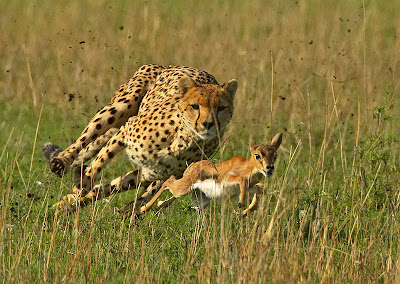

The research team believes that the behavior of a cheetah after a hunt depends on the territory it finds itself in. This increases the amount of time they spend eating, which in turn increases their overall handling time." "They spend more time paused before eating, perhaps also to catch their breath, and are more vigilant.

"Instead of speed, mothers use vigilance to minimize risk," explains Hilborn. Cubs can eat quite slowly because of the size of the cubs' mouths and their tendency to take regular breaks to rest or play. Mothers with cubs must first ensure the safety of their offspring and that they get enough to eat. They therefore spend little time watching out for attacks, and instead eat their prey as quickly as possible before it can be snatched away from them. The primary threat to male cheetahs and single females without cubs is having their kill stolen. The researchers established that the tactics cheetahs use depend on which type of threat they face from large carnivores. Hilborn and her colleagues studied 35 years of observations from more than 400 hunts involving 159 cheetahs in the Serengeti in northern Tanzania to find out how cheetah behavior while eating is altered by threats from larger predators. They therefore tend to hunt when larger predators are away or less active. Cheetahs do not have the strength to haul their kills up trees to keep them safe from scavengers as a leopard does, nor can they physically defend themselves against a lion. These large carnivores are known to not only attack cheetah cubs, but also steal prey in an act called kleptoparasitism. Here you will find options to view and activate subscriptions, manage institutional settings and access options, access usage statistics, and more.Cheetahs are medium-sized carnivores that live alongside large carnivores such as lions and spotted hyenas. If you believe you should have access to that content, please contact your librarian.įor librarians and administrators, your personal account also provides access to institutional account management. The institutional subscription may not cover the content that you are trying to access. Oxford Academic is home to a wide variety of products.

This authentication occurs automatically, and it is not possible to sign out of an IP authenticated account.Ĭhoose this option to get remote access when outside your institution. Typically, access is provided across an institutional network to a range of IP addresses. If you are a member of an institution with an active account, you may be able to access content in one of the following ways:

Get help with access Institutional accessĪccess to content on Oxford Academic is often provided through institutional subscriptions and purchases.


 0 kommentar(er)
0 kommentar(er)
